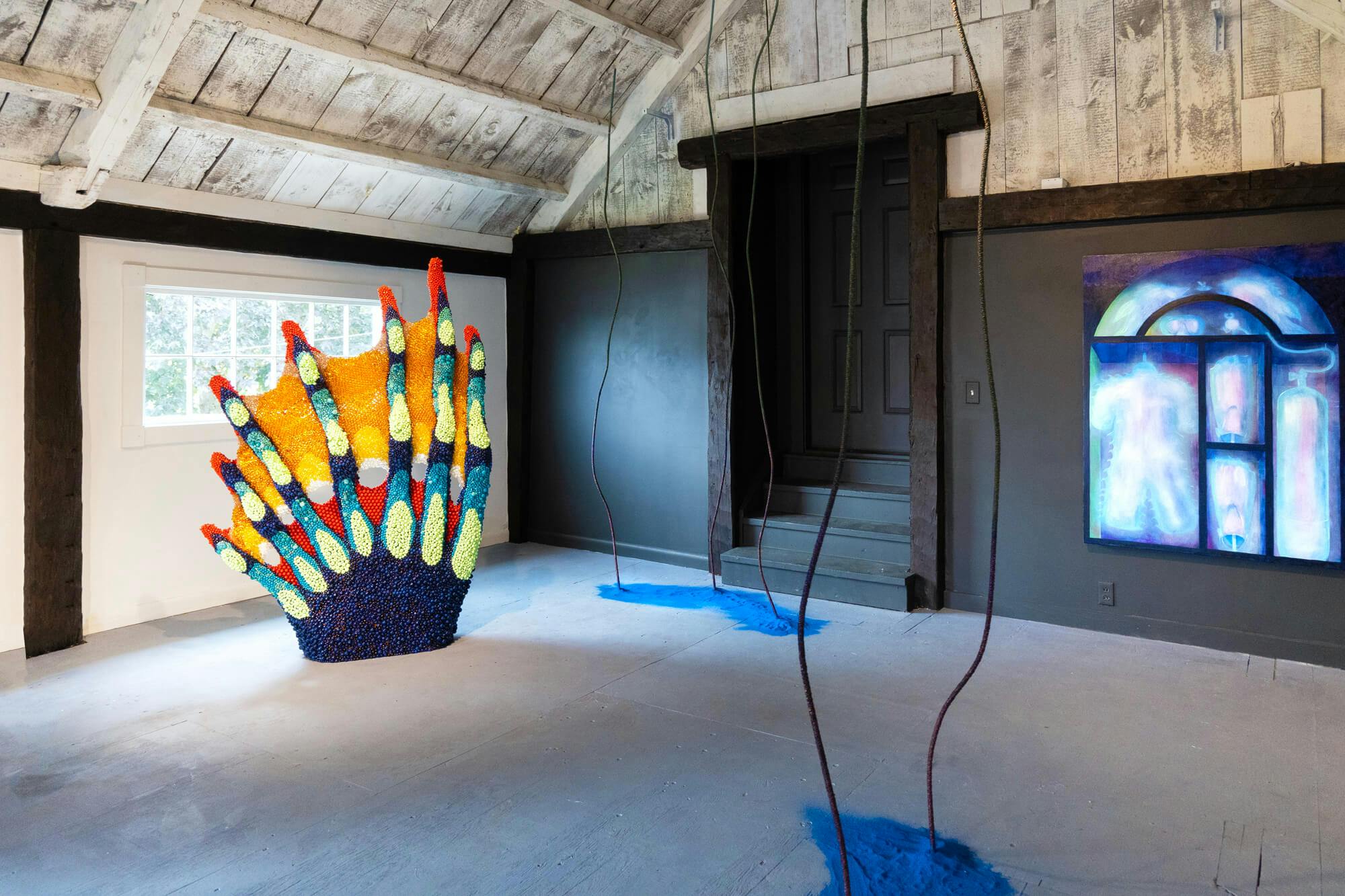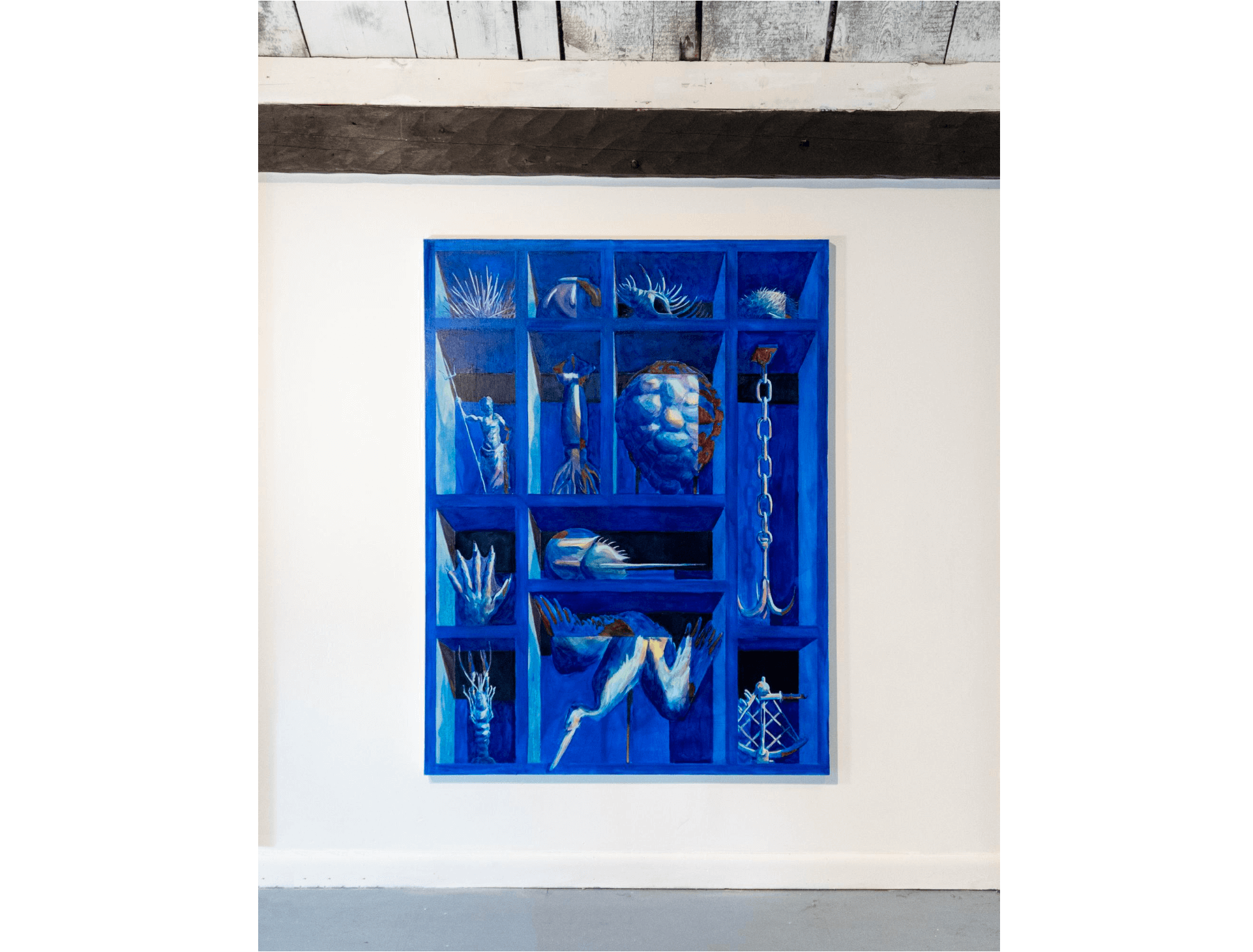Tucked away in mid-coast Maine, the Parsonage Gallery plays host to an exhibition of sculptures, paintings, and installations that imagine how humans might adapt to living in a world where our oceans are rising. Artist Brian Smith’s cheeky answer to this increasingly serious question posits that we might evolve into human-fish hybrids. Seen through the lens of queer ecology—a theory Smith often explores in his body of work—“That Queer Fish” argues that in the face of the climate crisis, we must move beyond traditional binaries to connect with and adapt to our changing landscape.
Queer ecology merges queer theory and environmental studies, asserting that queerness is a critical part of the environment. This lens asks us to reconsider long-held narratives about human mastery over nature, arguing that we are not separate from nature but a part of it. In an essay for The Years Project, writer Priya Subberwal expounds on this, arguing, “Queerness in ecology…is an all-encompassing wink to weirdness in the more-than-human world, and serves as an alternative to the binary and reductive modes of thought in which so many of us have been trained.” Looking at the world through this reframed view reveals new possibilities for understanding our own identities within the natural world. This exploration of identity and new connections to nature is central to Smith’s current body of work, seeking to close the gap between “human” and “nature.”
Smith, who trained as a sculptor at MassArt, includes several large-scale pieces in the Parsonage’s intimate upstairs gallery to anchor the exhibition. As you ascend the spiral staircase to the loft space, the vibrancy of Deepest Waters (2023) beckons you for a closer look. Surrounded by delicate, spindly “eel grass” rising to the gallery’s A-frame ceiling, Deepest Waters is unbelievably photogenic, and the intricacy of its assembly shows the careful study of form and detail. Thousands of acrylic and stone beads in vivid hues of orange, green, blue, and red create a swaying coral-like form. The blue-green projections joined together by orangey webbing are oddly hand-like, also reminiscent of the dazzling fins of a baby lionfish. Deepest Waters recalls Smith’s other recent explorations of natural forms, like A Field of Pansies with Their Guards Up (2023), created for the 2023 Center for Maine Contemporary Art Biennial, which featured five-foot-tall steel flowers with protective spikes. His reinterpretations of flora and fauna are meditations on color, figure, and identity, extracting eye-catching elements to create something new.
One of Smith’s most direct provocations on the theme is Future Mollusk (2023), sited steps away from Deepest Water. On a humble rock, a wetsuit is suspended between two fishing rods. The wetsuit—which for a moment seemed to float in the faintest contrapposto form—contains dozens, if not hundreds, of metal spikes, recalling the protective dermal spines of pufferfish. Like a suit of armor, Future Mollusk nods to the vulnerability of our land-dwelling bodies when we are forced to adapt to murky, watery realms. On the one hand, it reminds us of our limitations as a species and the lengths we might go to in order to “fix” this—it’s not too difficult to imagine a narrow-minded billionaire building a protective wetsuit for deep-sea tourism. On the other hand, it suggests that we might find protection or solace in nature if we engage with it in new ways.
Worth noting alongside his sculptures are Smith’s paintings—a medium relatively new for the artist. Blue Artifacts (2023), a large-scale, trompe l’oeil wunderkammer, hangs between Deepest Waters and Future Mollusk. Awash in ultramarine, the collection contains aquatic animals, sea-faring instruments, a Poseidon-like figure, and a mysterious hand from a being not unlike the Creature from the Black Lagoon. On an opposing wall, Smith plays with photoluminescence in Moonlit Horizon, as well as in the neighboring That Queer Fish, The Swimmers, and Phosphorescence. In these works, we see familiar objects repeat; most notably, Moonlit Horizon contains the likeness of the Future Mollusk wetsuit, this time accompanied by scuba gear, and the mysterious webbed hand in Blue Artifacts emerges from the depths in That Queer Fish.
In exploring these ideas in paint, Smith uses subtlety to create intrigue on the canvas, obscuring details that can only be revealed with a closer look; in The Swimmers, the human figure—or perhaps, Poseidon—is nearly concealed by a luminescent fish tail. Through the repetition of figures and objects, we can imagine Moonlit Horizon and Blue Artifacts as additional artifacts within the gallery, turning the entire room into an aquatic cabinet of curiosities.
Through pieces that engage our imaginations, Smith reminds us there is still much to learn about nature and its oddities. His playful use of narrative underscores a serious reality—as curator Dr. Aaron Rosen reminded me during my visit, the Parsonage Gallery is picturesquely located steps away from the Gulf of Maine, one of the fastest-warming ocean regions on the planet. As we stepped back out into the sun, it was difficult to reconcile the frightening future ahead with the pleasantness of the breezy summer air.
Smith understands this quandary. “That Queer Fish” stirs both joy and dread in the way that only artistic exploration can. It celebrates the mysteries of the ocean’s depths, but it reminds us of the unsettling predictions that will require us to adapt to living with water. After centuries of colonization and harmful attempts to claim mastery over it, the planet is responding and the time to grow beyond our narrow egos is now, if not yesterday.
But perhaps there is room for hope. Queer ecology prompts us to ask questions about our environment, to become curious, respectful participants in our ecosystems. This curiosity about our place in the natural world allows Smith to find light and even beauty in uncharted depths. When we reconsider the stories we tell ourselves and embrace our relation to nature, new possibilities appear.
“That Queer Fish: Brian Smith” is on view at the Parsonage Gallery through September 18, 2023.




